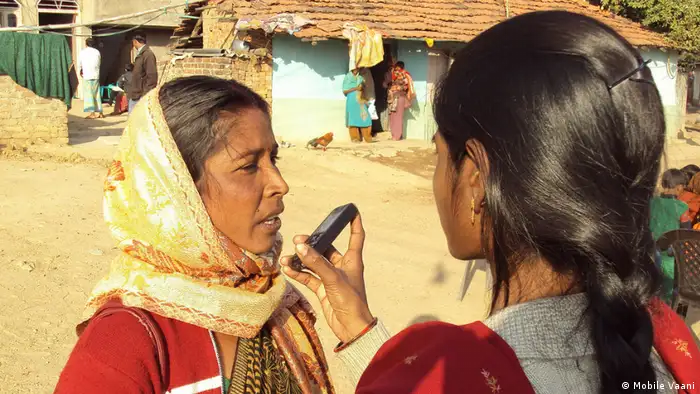Additions to innovation library
Digital innovations from mapping war to visualizing water
Digital technologies are being used for everything from creating visuals about water rights in Palestine to mapping massacres in Guatemala. Take a look at the latest projects in DW Akademie's Digital Innovation Library.

A Mobile Vaani volunteer from Kanke in the Indian state of Jharkhand is interviewing a community health worker
Uganda Radio Network
In the age of social media, verification has become paramount. This is why the Uganda Radio Network prioritizes careful verification before packaging and distributing information sent in by its network of citizen reporters in remote areas of Uganda. The network is the collaborative effort of a team run by Isaac Mugera. A seasoned journalist, Mugera has also worked as a district information officer for the local government. This has given him a deep understanding of the information gaps in his country and the need to encourage content from rural and remote areas. Mugera says URN's citizens reporting platform is innovative because it gets the views and opinions of ordinary people "into the daily media output, thus giving community voices access to mainstream media too." URN is a partner organization of DW Akademie.
Open Hluttaw, Myanmar
After 50 years of brutal military rule, Myanmar elected its first civilian government in March 2016. Computer scientist Soe Lin Htoot saw this opening up of the country as a valuable opportunity to create tools to support the journey of this young democracy. He co-founded a civic tech organization that launched Myanmar's first parliamentary monitoring tool in August 2016, Open Hluttaw. Soe Lin Htoot believes access to information is historically one of the major challenges for the Burmese. His long term goal is to cultivate a culture of engagement between the citizens and the state based on the factual data collected on the platform. In this way, citizens can best demand accountability and transparency from their elected leaders.
Mobile Vaani, India
Founded by Aaditeshwar Seth, Mayank Shivam and Parminder Singh in 2008, Mobile Vaani draws inspiration from social networks, with a twist – it uses an interactive voice response system that allows India's rural poor to call a number and leave a message about their community or listen to messages left by others. Mobile Vaani has more than 100,000 monthly users that call over 10,000 times a day in the north and north-eastern belt of India. Seth is a computer scientist leading a research group using applications of technology for social change, Shivam brings consulting and business expertise, having served in McKinsey's India office and Singh, an engineer, has extensive experience in the telecoms industry.
Dooz, Palestinian Territories
In the Palestinian municipality of Nablus, citizens are usually left out of decision-making processes. And because of Palestine's political situation, the media tend to report on national and international politics rather than on community needs and concerns. Verena Wendisch, Deutsche Welle Akademie's country coordinator for Palestine and project manager at Dooz, recognized this need. Together with the German development organization, GIZ, Wendisch initiated Dooz in 2012. The project focuses on featuring stories affecting locals in Nablus and also organizes public discussions to promote dialogue with the public.
Visualizing Impact
The NGO Visualizing Impact harnesses data visualization to tell stories about critical issues and push for social justice. Visualizing Palestine is the non-profit's first and largest project, aiming to add to the factual debate around Israel and Palestine by using data journalism. Visualizing Impact is the collaborative effort of Joumana Al Jabri, a former architect and Ramzi Jaber, an engineer by training. Since its founding in 2013, Visualizing Impact has developed their visualizations beyond issues in Palestine to partnering with an Egyptian news company to visualize censorship in Egypt and spread their model of storytelling to create change.
Mapeo de Memoria (Mapping Memories), Guatemala
Perhaps one of the youngest projects in the innovation library, Mapeo de Memoria was founded in August 2016. It's a digital map recording memorial sites dedicated to those who died during Guatemala's brutal civil war. The map project has drawn the attention of local human rights organizations who are using the information in accountability and reconciliation processes. The project is run by DW Akademie's David Olmos, a journalist with more than 10 years experience and a Guatemalan national. Mapeo de Memoria is not only concerned with visualizing the numbers of people who died, but also the stories of the victims who died, says Olmos.
Connectas
The driving motivation behind Connectas is to produce collaborative investigative reports with a Latin American transnational reach. The non-profit journalism project connects more than 160 reporters from 15 Latin American countries to advance the independence, quality, innovation and collaboration among journalists in the region. Connectas was one of the more than 100 media organizations working with the International Consortium of Investigative Journalists on the Panama Papers. Carlos Huertas, an experienced journalist, started the project in 2012 while at Harvard University as a Nieman fellow.
DW recommends
WWW links
- Date 19.07.2017
- Author Joan Okitoi-Heisig
- Feedback: Send us your feedback.
- Print Print this page
- Permalink https://p.dw.com/p/2gmHj
- Date 19.07.2017
- Author Joan Okitoi-Heisig
- Send us your feedback.
- Print Print this page
- Permalink https://p.dw.com/p/2gmHj
